|
G |
|
Gablonz:
A center of jewelry making in the Czech Republic, Bohemia. |
|
Gagate: Fossilized
coal also known as Jet. Used during the Victorian period
for mourning jewelry, it is black and hard. It can be found
in Whitby in England and also in Russia, Spain, Germany and
France. Jet leaves a brown mark and it is warm to the touch. |
Galalith:
An early form of plastic developed in Germany in
the 1890s that proved to be a welcome alternative to the
flammable celluloid. Used to imitate horn, ivory and
tortoise shell. Is was cost efficient , more durable than
celluloid and was tolerant of heat.
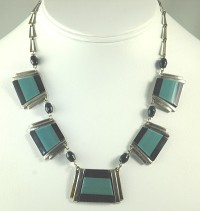 |
|
Jacob Bengal
Art Deco Chrome and Galalith Necklace |
|
Gallery: A strip of
metal that is pierced and can be used as a mounting for
gemstones. |
|
Garland Style: A type
of jewelry made popular by Cartier. It includes swags, bows
and tassels and it was popular during the early 20th
century. |
|
Garnet: A group of
many glassy minerals that are used as
gemstones. The members
of this group all share similar chemical structure. Pyrope
is the common deep red garnet that was usually found in
Victorian jewelry. Garnets come in many colors with the
exception of blue. Some members of this family include:
Andradite,
Demantoid
which is rare and green in color, and
Melanite. There are many more. They are relatively hard. It
was thought that the garnet would bring the wearer good
luck. The red garnet is the birthstone for January. |
|
Gaspeite: A
semi-precious gemstone that is pale to intense green in
color. It was discovered in 1966 in the Gaspe
peninsula in Quebec Canada. At first it was discarded as a
by-product on Nickel. |
|
Gemstone:
Now defined
as an semi- precious or precious stone, mineral or rock.
A gemstone was once considered to be a precious stone such
as a diamond, ruby or sapphire. |
|
Geode: A rock that is
hollow or partially hollow with crystals lining the inner
wall. The crystals are called druze. |
|
Georgian Period: Covers the period of 1714 - 1830
in British history. This period was during the reign of
Kings George I to IV. The reign of William IV [1830 - 1837]
is included. All of the jewelry from this time was handmade.
The styles ranged from Rococo to Gothic and Neoclassical.
During the reign of King George the first, jewelry consisted
of large extravagant stones. Diamonds were popular. In 1750
colored stones became popular. Pinchbeck [gold substitute]
was developed.
Cameos and
Intaglios were
popular and men wore jewelry. |
|
German Silver: An
alloy that is mainly copper with lesser percentages of
nickel and zinc and tin [alpaca]. German silver is also
known as nickel silver. There is no silver in German silver. |
|
GIA: Gemological
Institute of America |
|
Gilding: A piece of
jewelry or other item that is adorned with a thin layer of
gold foil, gold or gold leaf. |
|
Gilt: Coated with gold
or something that looks like gold. |
|
Gimmel Ring: Also
known as the Twin Ring is a ring made out of two or more
interlocking rings. It symbolizes the union of two people.
It was designed during the renaissance and it was the choice
of Martin Luther
when he married Catherine Bora.
|
|
Gipsy Setting: Or the
Star Setting is a setting that is recessed so that the stone
fits into it. There can be engraved patterns around the
setting that resemble stars. It was developed in the 1800s. |
|
Girandole: A style of
brooch or earrings where a large design element or stone has
three smaller, usually pear shaped pendants similar to the
larger element or stone suspended from it. |
|
Girasol: A yellow or
orange type of precious opal. Girasol means sunflower in
Spanish. |
|
Girdle: The edge of a
stone that is formed where the top or the crown and the
pavilion or the bottom meet. It is the widest part of a cut
stone. |
|
Givre: French for
frost or frost over. Beads in this style have
transparent glass fused around a translucent core. |
|
Glass:
Both natural [obsidian and moldavite]
and manmade [mix of sand, potash and lead that
is fused together] are used in jewelry. Manmade glass is
used most often to imitate other stones. Natural glass is
not. |
|
Glove Ring: A clip
that attaches ones gloves to another object such as a pocket
of purse. |
|
Glyptography:
Engraving stones with an abrasive. This technique is used
for cameos and intaglios. |
|
Godet: Metal pan that
hold cream or pressed powder within a compact. |
|
Gold: A precious metal
that when pure is very soft. Pure gold is 24Kt and is 100%
gold. Gold is mixed with other metals, usually copper to
make it stronger and less expensive. It is highly valued
because it does not tarnish. It is the most malleable of all
the metals and it is also ductile. The purity of gold is
measured in karats. Gold that is
alloyed comes in
several colors including; pink, white and green.
See chart. |
|
Gold Doré: A bar of
gold that has been through the first stage of the
purification process. It is about 90% pure. |
|
Gold Electroplate: A
process by which metal is coated with a thin layer of gold
or an alloy that is no less than 10 karats and no less than
seven millionths of an inch in thickness. |
|
Gold Filled: An item
of jewelry made of
base metal that has been coated mechanically with a
layer of gold. The weight of the amount of gold must be
equal to 1/20 of the weight of the item. Here is an
example of how Gold filled jewelry is usually marked 1/20
G.F. 12 Kt. This means that the item was coated with 12 Kt
gold and that the item is at least 1/20 gold. |
|
Gold Plated:
Base metal jewelry that has been coated with an extremely
thin layer of gold by the process of
electroplating. Jewelry that has received this treatment is
usually marked G.P.E. |
|
Gold Stone: Is
Aventurine that has fine gold colored inclusions.
Goldstone also refers to manmade glass stones with copper
inclusions. |
|
Gold Tone: Refers to a
piece of jewelry that has been finished in a gold color.
There is little if any gold in a gold tone item. |
|
Gold Washed: Jewelry
of other items with a thin layer of gold applied to the
surface. This thin layer, less than .175 microns in
thickness, is applied by dipping or burnishing the metal.
It is less durable than gold filled jewelry or
electroplating. Popular in the 1940s during WWII. |
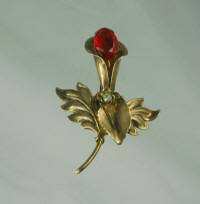 |
|
Gold Wash over Sterling Brooch Signed
Jolle |
|
Gothic Revival: In
terms of jewelry it is a style that imitates motifs of
jewelry popular in Europe in the 18th century. |
|
Graduated: When used
to describe a necklace it means that the beads go from
larger in the front and decrease in size towards the back. |
|
Grain: A measure of
weight for natural pearls and diamonds. Four grains are
equal to a caret. |
|
Gram Weight: The
weight measured in grams of metal used in jewelry. |
|
Granite: A common
plutonic and indigenous rock that is coarse grained and has
a visible crystalline texture. |
|
Granulation: Applying
decorative grains of metal to an object. These tiny beads
are soldered and form a pattern on the object. This
technique was sometimes used in Etruscan Revival jewelry. |
|
Grape Garnet: Found in
northwestern India, these are rare violet to deep purple-red
garnets made of almandite and spessartite. |
|
Greek Key: A design
pattern of interlocking and repeating geometric shapes. |
|
Green Diamond: Rare
and valuable fancy
diamonds. |
|
Green Garnet: A
demantoid garnet that was popular in the 1800's. They are
rare and have inclusions that look like horsetails. |
|
Green Gold: Gold that
has been alloyed with a high silver content and other metals
including copper. |
|
Greenstone: Also known
as Nephrite it is a volcanic rock and a variety of jade. |
|
Grelot: Beads that
have an elongated and pendant shape. |
|
Grey Gold: Gold that
has been alloyed with 15-20% iron. |
|
Griqualandite: A South
African Tiger-eye gemstone with bands of yellow and brown
that when viewed from the opposite direction the colors are
reversed. |
|
Grooved: A long narrow
channel that is routed in a line. |
|
Grossularite: A garnet
that is pale green, black, pink or brown and is translucent. |
|
Guilloché:
A type of
enameling where a design is
engraved
and then coated with a translucent enamel so
that the engraving shows through. |
|
Gunmetal: A type of
bronze that is nine parts copper and one part tin. |
|
Gutta Percha:
A rubber
formed from resin or sap of the Gutta tree. Used to make jewelry in
the 1800s. |
|
H |
|
Hair Jewelry: Jewelry
containing locks of hair usually from a loved one. It was mostly
preserved in a locket or woven into bracelets, chains or earrings
and given as affectionate mementoes. This style of jewelry was
popular during the mid 1800s. Very desirable and collectable today. |
|
Half-hoop: A ring,
bangle or a
bracelet where only half of the item is set with stones. |
|
Half-hoop Design: A
ring that is similar to an earring but does not form a
complete circle. |
|
Hallmark: A mark or a
series of marks impressed into metal to indicate the
fineness of the metal, the country of origin, the designer
or manufacturer. Hallmarks may also contain the date of
assay or manufacture or the date a design was registered or
patented. Hallmarks are a way to protect consumers against
fraud which was prevalent in the past. In many countries
precious metal has to be stamped with a quality mark. If the
item says sterling it must contain .925 [92.5%] parts
silver. These countries may also require that the item be
tested by an official agency prior to stamping. In the USA
precious metal does not have to be marked for quality. If a
quality mark is present the piece must also contain a
registered trademark. The issuing body is the United States
Patent and Trademark Office. Many jewelry items in the
USA contain trademarks that are not registered.
A hallmark can also be found on metal or paper tags. |
|
Hammered: To dimple,
shape or texture a piece of metal with a hammer. |
|
Hardness: Hardness is
measured by the Mohs Scale of Hardness and it is the ability
of a stone or surface to resist scratching. |
|
Heishe: A Pueblo term
that means shell. This is the oldest form of jewelry in New
Mexico. Heishe refers to pieces of shell that have been
ground into beads that were then used to make necklaces.
Other material such as lapis and turquoise were/are also
used. |
|
Helenite: Manmade
green glass processed from rock dust taken from near Mt. St.
Helens volcano in Washington State. This is not volcanic
ash. |
|
Heliotrope: A type of
chalcedony that is green with red spots that look something
like blood. It is also known as
bloodstone. |
|
Hematite: A natural
iron oxide. It is a bluish to black or silvery opaque stone
that turns to red when ground. |
|
Herringbone Chain: A
flat chain that is created by small slanting links
resembling the spine of a herring. |
|
Hessonite: Sometimes
called " cinnamon stone" this is a form of grossular garnet
and this gemstone is transparent. |
|
Hidden Box Clasp: A
type of clasp that when secured only the release lever is
visible. This type of clasp is hidden underneath the last
link of a chain. |
|
Hook and Eye Clasp: A
finding used to connect two sides of a bracelet, anklet or
necklace. It is comprised of a hook on one side and a ring
[eye] on the other. The hook is latched to the ring to
fasten the item. |
|
Hoop Earrings: An
earring that is circular in shape and made out of wire or
tubing. |
|
Howlite: Named for its
founder, a Nova Scotia geologist Henry How, this soft white
mineral with gray or black inclusions can easily take to
dye. It is often dyed to imitate turquoise. |
|
Hunting Case: 1. A
pocket watch with a lid on the front and on the reverse. 2.
A watch that has a lid that can be opened by pushing on the
crown. |
|
Hyacinth: A type of
zircon that ranges in color from orange- yellow to
yellow-brown. This
semi- precious stone can also have an amber like color.
|
|
I |
|
ID Bracelet: An ID
bracelet is one with a plaque that is engraved with the name
of a person, usually the wearer. ID is short for
identification. |
|
Imperial Jade: Another
term for emerald jade. |
|
Imperial Topaz: The
most valuable topaz. It is rare and yellow-orange in color. |
|
Imperial Mexican Jade:
A
calcite that has been dyed green. It is not jade. |
|
Inclusion: A flaw such
as a foreign matter or a particle that is naturally
occurring in a stone. |
|
Indicolite: A
blue-green tourmaline. |
|
Ingot: Metal that has
been cast into a particular shape, usually a bar. |
|
Inlay: Layering or
embedding a piece of glass, stone or other material
upon another. The receiving surface is cut and the
second material is embedded. |
|
Intaglio: A method of
engraving or carving a design below the surface of an object
such as metal or stone. |
|
Invisible Necklace:
Also called a floating necklace. A necklace in which the
beads a strung far apart on almost invisible wire or thread. |
|
Invisible Set:
Gemstones set side by side with no metal between them and
usually in two or more rows. |
|
Iridescent: To have a rainbow
like appearance when viewed from different angles.
|
|
Iridium: A hard yellow-white
metallic that is part of the platinum family. It is often used
with platinum to make it more workable. |
|
Iron:
An element that is
heavy, ductile and magnetic. It is silvery-white in pure form and it
easily rusts. It usually does not have any luster except in its
pyrite and marcasite forms. |
|
Irradiation: The method of
exposing a gemstone to high-energy radiation to change its crystal
structure. This process is often used to change a stones color. |
|
Ivory:
Animal ivory comes
from the tusks or teeth
of elephants and mammoths. It is one of the oldest materials used to
make jewelry and other adornments. Similar to bone in composition, but ivory
does not have a blood vessel system, making it more dense than bone.
Ivory can be white or yellow. Synthetic ivory is made from plastic
like
celluloid.
French ivory is a synthetic type of ivory. Vegetable ivory comes
from nut of plants found in South America. |
|
|
|
J |
|
Jacinth: Another name for
Hyacinth. |
|
Jade:
A natural hard stone
that is usually green in color. This semi-precious stone can
also be found in lilac, close to brown and black and almost
white. There are three types of jade- Jadeite,
nephrite and chloromelanite. |
|
Jade Glass: Imitation
jade that is green and translucent. |
|
Jadeite: A rare and
more valuable type of jade. It is hard and translucent and
comes in a variety of colors. |
|
Japanned: Refers to a
black varnish used to finish jewelry. |
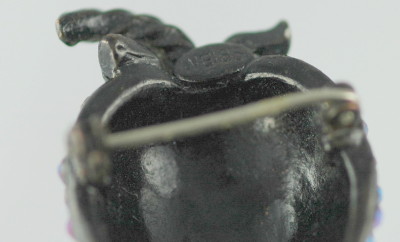 |
|
Weiss Strawberry Rhinestone Pin with Japanned
Backing |
|
Jasper: A form of
quartz that is common. It is an opaque member if the
chalcedony family that can be found in many colors including
stripes. |
|
Jasperized Wood: Wood
that has fossilized, becoming stone like in appearance. |
|
Jasperware: Stoneware
that is matte in finish. It is usually blue and white but
can be found in other colors. This technique was made
popular by Josiah Wedgwood. |
|
Jelly Belly: Jewelry,
usually an animal that has a clear
acrylic, Lucite stone at the belly or at
the center of the item, usually a pin. Created by
Trifari in the 1940s and
copied by others including
Coro. |
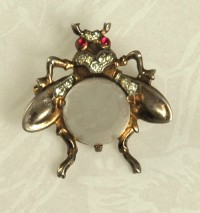 |
|
Trifari Sterling Jelly Belly Fly Pin |
Jet: A type of wood
that has been fossilized. Jet is related to coal. It is hard
and very light in weight. Most natural Jet is mined in Whitby, England. It is black in color
or dark brown and was often used in
making the mourning jewelry popularized by Queen Victoria
after her husband died in 1861. Synthetic Jet is made of
glass, horn, gutta-percha,
onyx and bog-oak. French Jet is not Jet, but actually black
glass. Jet will smell like burning coal if pricked with a
hot pin tip.
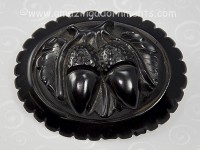
Antique Whitby Jet Brooch with
Carved Acorns |
|
Jewelry: An adornment
for the body made from metals that can be set with stones,
glass or other material. |
|
Job Lot: Merchandise
sold together in one lot. |
|
Jobber: [1] A person
who buys job lots for a manufacturer or a wholesaler to
be used in a specific display. [2] A manufacturer or
wholesaler that manufacturers jewelry by the job for a
another company. De Lizza and Elster, the makers of
Juliana jewelry were the jobbers for many companies
including, Kramer, Weiss, and Alice Caviness. |
|
Jugendstil: Means "Youth Style" in German. It was
a style that was popular in the late 19th and the early 20th
century. The term originated in 1886 when it was first
published in the weekly Jugend which was a trend-setting
publication. It is similar to the Art Nouveau style. The
motifs were characterized by curves, floral and naturalistic
flowing designs. |
|
Jump Ring: A finding
for jewelry making that is small, circular or oval and that
is used to connect items to a chain or to attach to other
rings. There is usually an opening in the ring that is
pressed shut. |
|
|
|
K |
|
Karat:
A measure of the fineness of gold. Abbreviated "Kt".
Pure gold is very soft, so it is often alloyed with other
metals to give it strength. The gold item is then marked to
show the amount of actual gold in the piece.
24 karat = pure or 100% gold,
18 karat = 18/24 or 75% gold,
14 karat = 14/24 or 58% gold,
12 karat = 12/24 or half gold
and 10 karat = 10/24 or 41.7%
gold. Early jewelry made before the 20th century was
not marked. Other marks found on gold are: 750= 750 parts
gold out of 1000 for 18 karat gold and 585 for 14 karat.
|
|
Karatclad: Gold electroplating that is 14 times
higher than is required for marking purposes. It is harder
and does not tarnish as easily. It was the first heavy gold
electroplating. |
|
Keeper Ring: A less
valuable second ring that is used to keep a more expensive
ring on the finger. |
|
Keystone: A
stone that has been cut in the shape of a keystone. They are
usually step cut with many facets parallel to the edge of
the stone. |
|
Kidney Wire: A type of
earring finding for pierced earrings. They date back to the
1870s and are still in use today. |
|
King Cut: Used for
large diamonds this is a variation of the brilliant cut that
has 86 facets. |
|
Kunzite: A gemstone
that looks like rose quartz and that fades in bright light. |
|
Kyanite: A mineral
that is blue-green, gray or white. It is an aluminum
silicate. The name comes from the Greek "kyanos" which means
blue. It has a columnar crystal habit. |
|
|
|
L |
|
Lab Created Stone: A
manmade stone that mimics the structure of a natural
stone. They are less expensive than their natural
counterparts. These are not "fake" stones. |
|
Labradorite: Part of
the feldspar group, it is a dull gray mineral unless viewed
from certain angles. |
|
Laminate: To cover
with a thin layer/sheet of a material. |
|
Lampwork: Beads made
by hand by manipulating hot glass and wire. Millefiori
is an example of a lampworked bead. This technique was
invented in Murano, Italy. |
|
Lanyard: Also spelled
laniard, this is a rope or a cord that is worn around the
neck and is intended to carry an object. |
|
Lapidary: [1] A person
who cuts, engraves and polishes gemstones. [2] A person who
deals in gemstones. |
|
Lapis Lazuli: A deep
blue opaque semi- precious stone who's history as a gemstone
goes back to 5000 BC. This rock consists of many minerals
including; calcite [white veining] pyrite [yellow flecks]
and sodalite [blue]. It is often dyed to enhance its color
and it scratches easily. |
|
Lariat: A necklace
that has both ends dangling rather than clasped. The wearer
can tie both ends into a knot. Some lariats have a
snap to secure the ends.
Miriam
Haskell's company produced many necklaces in this style. |
|
Laser Drilling: The
process of removing flaws from a gemstone by drilling a
small hole and removing the inclusion. |
|
Lathe: A machine that
is used to turn metal or wood. |
|
Lava:
Molten rock that
comes from volcanoes. Lava jewelry was popular in the
nineteenth century. Lava jewelry is actually made out
of Limestone. |
|
Lavalier: A necklace
or an earring with a pendant that has a stone or stones
dangling from it. |
|
Lead: A chemical
element that is soft, heavy and toxic. It is metallic and
malleable. It is bluish white in color when freshly cut,
but will tarnish to a dull gray. |
|
Lead Crystal: Glass
that contains at least 24% lead oxide. English glassmaker
George Ravenscroft developed this process in 1676. |
|
Leather Cord Jewelry:
Beads, shells and other items strung on leather to make
necklaces, bracelets and anklets. |
|
Lever Back: An earring
finding for pierced ears that bends and attaches behind the
ear with a hinged lever. |
|
Limestone: Used to make jewelry,
mostly cameos in Italy during the mid- 19th century.
Some call this Lava.
|
|
Limoges: A company
from France that produces fine china. |
|
Linde Star Sapphire: A
synthetic star sapphire developed in 1967. |
|
Lobster Claw Clasp: A
jewelry finding that is used to connect one end of a
bracelet, necklace or anklet to the other end. This finding
has a spring that when depressed opens the clasp. The clasp
looks a bit like the claw on a lobster, thus the name. |
|
Locket: A pendant or a
case that opens and often contains hair, a picture or other
memento. |
|
Lorgnettes: Eyeglasses
that have a long handle used to hold the glasses to the eye.
Also called opera glasses, they are small binoculars. |
|
|
|
Lost Wax Casting:
A method of casting metal that has been around for 1000s of
years and is still used today. An original object is made of wax or
clay and then a mold of plaster or latex is made of the original
object. Very hot wax is then poured into this mold producing a copy
of the original. This copy which is hollow is then removed. The
seams are smoothed over with a hot metal until it looks like the
original. Once this is accomplished, more wax is applied that will
provide the path for hot bronze to flow into. This is now dipped in
wet a ceramic substance and then into a mixture of sand plus powered
clay. This coated object is placed in a kiln. Once hard, this
ceramic object is taken out of the kiln and cooled. It is tested to
make sure there can be no leakage. It is placed back into the
kiln, then into sand where hot bronze is poured into it. This
shell is allowed to cool. After it is cool the shell is taken off.
The remaining bronze is then smoothed and given patina. Known as
cire perdue in French.
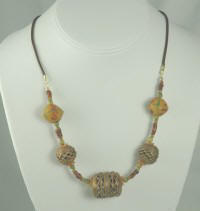
|
|
The brass beads used in this necklace were created using the lost
wax casting method.
|
|
|
|
Lucite: A thermoplastic
[acrylic] resin that is strong and hard. It is clear, but can be
colored. The DuPont company patented this type of plastic in 1937.
Ages well compared to most other plastics. |
|
Luster: The way a stone
reflects the light. There are different types of luster including:
greasy, pearly, waxy and metallic.
|
|
|
|
M |
|
Mabé Pearls: A cultured
pearl that grows on the shell of an oyster. The result is a
spherical shaped pearl with a flat back. |
|
Machine Age:
An era between 1925 to about 1928 when design lines were
simple and austere. The Paris Exhibition and the Worlds Fair in New
York, NY USA occurred during this period. One prominent jewelry
designer was Jacob Bengel. |
|
Malachite: An opaque light to
dark green mineral that is used as a source for copper and
that has been used for making jewelry for thousands of years. |
|
Malleable: Means that a metal
can easily be worked with a roller or a hammer. |
|
Maltese Cross: The badge of
the Knights of Malta, it is a cross formed by four arrow heads
meeting at the points. |
|
Mandrel: A bar or a spindle
that is used to retain the shape of a cavity during the milling
process. Can also be used to reshape a ring or to stretch the band
of a ring. |
Mantilla:
Originally a head scarf meant to cover the head of a Catholic
woman. Mantilla head combs are usually long, but can be found in a
lower profile. They were originally meant to be worn with a scarf.
During the
Art Deco era, Auguste Bonaz made some of the most striking and
sought after mantilla style hair combs in celluloid and
galalith.
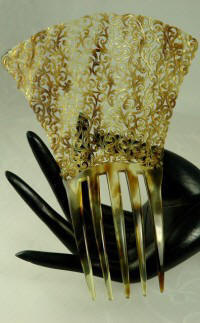 |
|
Auguste Bonaz Art Deco Mantilla Style Celluloid
Hair Comb |
|
Marble: A rock that is hard,
crystalline and metamorphic. It is used as a building material, for
ornamental objects and it polishes to a high shine. |
|
Marbled: A pattern with
streaks or swirls that resemble a marble. |
|
Marcasite: A mineral that has
the same chemical formula as Pyrite, however it differs in chemical
structure. The mineral form of marcasite is not usually used for
jewelry. Marcasite [iron pyrite] used for jewelry is shiny with a
metallic appearance. Sometimes used as a substitute for diamonds. |
|
Mariner Link Chain: A chain
with a series of oval links. Each oval has a bar down the center. |
|
Marquise: A stone that is cut
in the shape of an oval with pointy ends. Also called a "Navette"
this cut was named after the mistress of King Louis the XV, Marquise
de Pompadour. |
|
Matinee Length: A single
strand necklace that is 20 to 26 inches long. |
|
Matte: A finish for jewelry that is also
known as brushed. The top layers of the surface is scratched creating lines.
This finish reduces the surfaces reflectivity.
|
|
Memory Wire: A metal wire that
retains its coiled shape. It looks like a slinky and is often used
for making bracelets. |
|
Mesh: A type of fabric that
has a net like appearance. It is created by weaving thin wire
together. |
|
Metal: A solid element that
conducts electricity and is malleable and
ductile. |
|
Metallic: A metal like finish
applied to beads, fabric or yarns. Also any material that
contains metal is called metallic. |
|
MFA: Museum of Fine Arts ~
located in Boston, MA. |
|
Mica: A mineral that has
perfect cleavage in one direction, There are several different types
and a variety of colors. They are used as an electrical insulator
and in the manufacturing of heat sensitive materials. |
|
Micromosaic: A mosaic or
picture made from very small pieces of tile, glass or stone called
tesserae. |
|
Millefiori: Italian for "a
thousand flowers". It is an old technique using colored rods that
are fused together. They are cut and embedded in glass. |
|
Milligrain Setting: A type of
setting in which tiny beads or grains of metal secure the gemstone.
Bands made of tiny beads of metal are also used in this way. |
|
Mine Cut: A type of cut that
was used for diamonds in the 1800's. It has a cushion or square
shape rather than the round outline of more modern cuts. |
|
Mineral: A naturally
occurring substance that is not animal or plant. It is
inorganic.
|
|
Mixed Cut: A style of cut
where the facets are different below and above the girdle of the
gemstone |
|
Modernist Jewelry: A wide ranging term that describes
jewelry produced by some, during various artistic and social reform movements that was broad culturally
beginning with the Arts and Crafts Movement of the 1890s. The
movement began as a rebellion against the 19th century academic way
of thinking and evolved into a wide movement that embraced change
and technology as well as new ways of thinking about art and artist.
This jewelry was usually hand-made rather than mass
produced.
American Modernist artists during the mid- 20th century had many of
the same social and artistic concerns. This movement was concentrated in Greenwich Village, New York,
although not limited to this vibrant, avant garde locale. Simple geometric lines and Biomorphic designs are two examples of
this type of jewelry. |
|
Mohs Scale:
Measures a
substances hardness and resistance to scratching. It was invented by
Friedrich Mohs of Austria. The range used is 1 to 10. The
number one represents Talc which is the softest, while 10 represents
diamonds, the hardest. A substance is harder than another if it can
scratch it. A diamond can scratch Talc or a ruby for example but
neither can scratch a diamond. |
|
Moissanite: Silicon Carbide
used as a gemstone. It is a hard mineral [crystal]that ranges in color from
colorless to yellow and blue, green. It looks like a diamond
and will sometimes tests as one. Moissanite can be synthetically
produced. |
|
Moldavite: A dark green
gemstone found in the Czech Republic. It was formed when a meteorite
hit the earth and fused with the rocks already present. |
|
Molded Cameo: Cameos that are
not carved, but rather formed in a mold. They are usually
plastic, porcelain or glass. |
|
Mollusk: Invertebrate animals
such as a snail, oyster, clam or squid. They have soft bodies
that are usually enclosed in a hard shell. |
|
MOMA: Museum of Modern Art,
New York City. |
|
Monoclinic: A crystal
structure where the vectors [the crystal system] are of unequal
length. Two of the vectors are perpendicular while the third vector
makes an angle that is not 90° with the plane that the other two
vectors form. Jade and moonstone are monoclinic. |
|
Montana Ruby: Is not a ruby,
but rather a pyrope garnet. |
|
Moonstone: A translucent
gemstone with a pearly luster. It is a feldspar and is usually cut
in the cabochon shape. It is monoclinic and was very popular
during the Art Nouveau period. |
|
Morganite: A pink variety of
beryl that contains manganese. It was named after J.P. Morgan, the
American industrialist who also collected gems. |
|
Mosaic: Decorative art made by
cementing small pieces of tesserae [glass, stone or tile] onto
a surface. |
|
Moss Agate: Is a chalcedony
that is semi-transparent to opaque and green in color with some
white or clear inclusions. It is also called mocha stone. |
|
Mother of Pearl: The inner
coating of a mollusk that is scraped off and used for jewelry, inlay
for furniture and other items. |
|
Mother's Ring: Rings that
mother's have personalized with the birthstones or names of their
children. |
|
Mottled:
A surface that has splotches, dots or variegation. |
|
Mount: To fit a stone into a
setting. |
|
Mounting: Metal that holds a
gemstone into place. |
|
Mourning Jewelry: Jewelry that
is worn in remembrance of a departed friend or loved one. This type
of jewelry is usually black and became popular after Queen
Victoria's husband Prince Albert passed away. Victoria went into
very deep mourning and wore black during this period. This type of
jewelry was made out of bog oak, gutta percha, jet or black glass.
Hair jewelry is also considered mourning jewelry. |
|
|
|
N
|
|
Nacre:
The calcium carbonate substance that a mollusk secretes
around an irritant. This substance over time forms a natural
pearl. |
|
Natural Pearl: Formed
over years by a mollusk as a reaction to an irritant such as
sand. |
|
Navette: The same as a
marquise cut stone. The terms are used interchangeably. |
|
Necessary: A small
purse like object usually worn on a chatelaine. It held
objects such as rouge, a pencil or coins. |
|
Necklace: Jewelry worn
around the neck. |
|
Negligee Pendant: A
lavalier necklace. |
|
Neoclassical: A
revival of ancient Greek and Roman style. |
|
Nephrite: A green to
white rock that is hard and is one form of jade. It is also
called "greenstone". Nephrite can also be found in
other colors including brown and it often has veins. |
|
Nickel Silver: An
alloy of zinc, copper and nickel that was invented in
Germany as a substitute for silver. Also called "German
Silver". It does not contain silver. |
Niello: Is a black
substance comprised of sulfur, silver, copper and lead used
to fill in an engraved design. This process has been around
since ancient times.
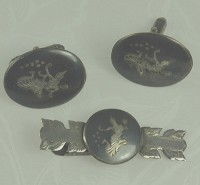 |
|
Niello Sterling Silver Cufflinks and Tie Bar Set |
|
Noble Metal: Metals
that do not corrode and that are resistant to oxidation.
These metals are gold, platinum and silver. |
|
Nonmetallic: Refers to
a material that contains no metal. |
|
Nose Stud:
Jewelry worn in a pierced nostril. Usually a
ball, stone or a post. |
|
Nugget: Describes a
piece of irregularly shaped precious metal. |
|
|
|
O |
|
Obsidian: A dark or sometimes
clear volcanic rock that forms into glass by fast cooling lava. It
was used in ancient times to make sharp tools. |
|
Oiling: An ancient technique
that is used to improve a gemstones color. Mostly used on emeralds,
it is the process of applying oil to the stone to fill in the
cracks, thereby improving the clarity and helping to prevent
brittleness. |
|
Old European Cut: A style of
cutting a stone that was popular in the 1800s. It is a round
brilliant cut and has 58 facets. This cut has a high crown, a deep
pavilion and an open cutlet. |
|
Old Mine Cut: A style of
cutting a stone into a cushion shape with a high crown. |
|
Onyx: A semi-precious stone
that is a variety of Chalcedony. It is banded or layered in black
and white. Some Onyx can be found naturally, however some is
produced by staining agate. It is often used to make intaglios and
cameos. Also used for making beads. |
|
Opal: A semi-precious
amorphous [non-crystalline] variety of silica. They are also
comprised of water which makes them easy to crack. The
characteristically display an ability to change colors and have a
distinctive iridescence. Opals also have inclusions of several
colors or "fire". |
|
Opalescence: Describes a
minerals ability to exhibit different colors like an opal. |
|
Opaque: A substance that is
impenetrable by light. |
|
Open-work: Is similar to
filigree. It has a design that is open in spots. |
|
Opera Length: A single strand
necklace usually pearls that can range in length from 28 to 35
inches. Also describes necklaces up to 90 inches in length. |
|
Oriental Pearl: Refers to a
natural pearl that is formed without human intervention. |
|
Ormolu: An alloy of copper,
tin and zinc that is used as a gold substitute. French for ground
gold. It is gilt bronze that is used to decorate objects. Also
called bronze doré. |
|
Oval Cut: A style of cutting a
stone into a elliptical shape. |
|
Oxidation: A chemical reaction
to oxygen that causes metal to darken or rust. |
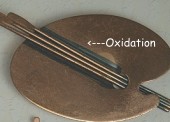 |
|
"Renoir" Palette Brooch with Oxidation [black
Streak] |
|
|
|
P |
|
Palladium: A
metallic element that belongs to the platinum family.
It is silver white and does not unless heated. It was first
used for jewelry making in 1939 as platinum was being used
for WWII efforts. Palladium is often alloyed with
gold. The marks Pd will appear before a number on jewelry
made with palladium. |
|
Palmette: A common
motif in Greek and Persian art. It is based on the shape of
a palm leaf. |
|
Paper Roule: Rolled up
paper, usually triangles that are shaped into beads. |
|
Party Case: See
Carry-all. |
|
Parure: A matching set
or a suite of jewelry. The number of pieces necessary vary.
A full parure is now known as a matching necklace, bracelet,
earrings and a brooch. Two bracelets were necessary for a
full parure in earlier times. Parure is French for "personal
adornment". |
|
Paste: A term used to
describe glass that is used to imitate gemstones. This term
has been in use since the 18th century. |
|
Paté de Verre: A
process of grinding glass to a powder that has been
around since the ancient times. A binding agent is added to
the powder, creating a paste. It is then colored, put
into a mold and fired. This process became popular again
during the
Art Nouveau time period. |
|
Patina: A change in
the surface appearance of an object due to oxidation, age
and wear. Patina can be naturally occurring or artificially
applied. Removing natural patina can sometimes lessen the
objects value. |
|
Pavé: A style of
setting gemstones very close together so that the metal does
not show. |
|
Pavilion: The pointed
section of a gemstone that sits below the girdle. Usually
this is the lower portion of a set stone, it ends with the
cutlet. Henry Schreiner
of New York City made jewelry with this portion set face
up. |
|
Pavilion Height: The
distance from the girdle to the bottom or the cutlet of a
gemstone. |
|
Peacock Pearl: Is a
very dark green pearl that like other black pearls is
produced by an oyster |
|
Pear Cut: A type of
gem stone cut that resembles a tear. It is rounded on one
end and pointed at the other. |
|
Pearl: A natural mass
that grows within a mollusk as a result of nacre production.
The nacre or mother of pearl is produced as the reaction to
a foreign particle. The foreign object is coated with this
lustrous substance. It can take years for a pearl to be
formed by this process. The most sought after pearls are
perfectly round. There are three types of pearls:
cultured, natural, and simulated. Pearl names: Oriental, baroque, Mabe, blister,
freshwater, Awabi and seed pearls. |
|
Pearlescent:
Iridescent. Resembling a pearl or nacre in luster. Having a
play of a rainbow of colors like an oil slick. |
|
Peking Glass:
Describes a type of glass that is opaque to transparent. It
was first made in China in the 1600s to imitate porcelain. |
|
Penannular Brooch: A
type of brooch that is circular and has a gap. There is a
pin attached to the circle. They were used to fasten
material, usually a cloak. They are a type of Celtic
jewelry. |
|
Pendant: An adornment
that hangs from a necklace, bracelet or an earring. |
|
Petrified Wood:
Fossilized wood or wood which has had its original tissue
replaced by rock. |
|
Pewter: A metal alloy
that is also called "antique silver". At one time
pewter was mostly a lead alloy. It is now copper, 90% tin
and antimony. |
|
Pierced: Punching a
hole through an object. As relating to jewelry patterns are
cut out of the metal with a chisel or other object leaving
an attractive pattern behind. |
|
Pierced Earrings:
Earrings that are meant to be worn through a hole in the ear
lobe. |
|
Pietra Dura: A
technique of inlaying popular in Italy. It is the process of
inlaying hard stones into softer stones or furniture. |
|
Pin: Jewelry items
that are attached by means of a rod, catch and a hinge
mechanism. Also called brooches. Jewelry items can
sometimes be dated by the pin mechanism. |
|
Pinchbeck: An alloy of
tin, zinc and copper that was developed by Christopher
Pinchbeck in the 18th century. It was used in jewelry making
to imitate gold. |
|
Pique: A style of
decoration where tortoise shell or ivory is inlaid with
silver, gold or mother of pearl. This style was popular in
the 18th and 19th centuries. |
|
Plating: Coating one
metal with another by using electricity. |
|
Platinum: A
silvery-white precious metal. It is the rarest of the
precious or noble metals and it is harder and has a higher
melting point. It is not easy to alloy or work with this
metal. jewelry made out of platinum is usually 90% to
95% pure. Platinum is hypoallergenic and it does not easily
tarnish. The mark used in western countries to signify
platinum is PLAT. |
|
Pleochroism: A
phenomenon in which a stone will show several colors when
viewed from different angles. |
|
Plique-à-jour: A form
of enameling similar to cloisonné that was popular in
Art
Nouveau jewelry. The transparent enamels are held in place
by metal wire around the edges and has no background. It
resembles stained glass. René Lalique was considered the
master of this technique. |
|
Poesy: A ring or other
item of jewelry that was popular during medieval times. It
usually had a love poem or verse inscribed on or in it. |
|
Poincon: A mark that
is placed on silver and gold jewelry or articles in France
to identify the purity of the item. It is similar to the
English hallmarks. |
|
Point: A unit of
measure used to describe gemstones. It is the smallest unit
equal to 1/100 of a carat or 0.002 gram. |
|
Poison Brooch: A
brooch that looks like a normal brooch but has a top that
opens on a hinge and that could have held poison. |
|
Poison Pendant:
A pendant that appears normal, but is actually a box
with a hinge that can open to reveal a place that poison
could be placed. |
|
Poison Ring: A ring
whose top opens on a hinge and could have held poison.
The ring looks like a normal ring when the top is closed. |
|
Polychrome: A
decoration or a design that has three or more colors. |
|
Porcelain:
Clay to which kaolin has been added and fired at a high
temperature |
|
Porous: Having tiny
holes that allow substances to be absorbed. |
|
Post: An earring
finding that is attached to the back of a ear stud and is
intended to pass through a hole in the ear. |
|
Pot Metal: An alloy of
copper and lead that was used to make pots. It is also
called "white metal". It was also used to make
inexpensive jewelry. |
|
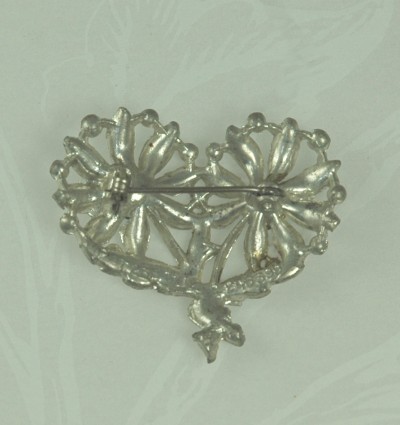
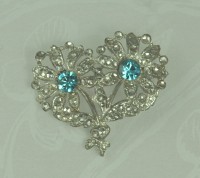 |
|
Pot Metal Double Floral Pin |
|
Poured Glass: A
technique in which hot glass is poured into the setting. On
a piece of jewelry using this method you will see some of
the spillover on the reverse of the item. |
|
Prayer Ring:
A ring
whose top opens on a hinge and could have held a piece of
paper with a prayer written on it.
The ring looks like a normal ring when the top is closed. |
|
Precious Metal: These
are metals that are valuable and rare. The precious metals
include; silver, gold and platinum. |
|
Precious Stone: Is a
gemstone that is rare and valuable. |
|
Pressed Horn: Bone/natural substance usually from an animal
that is light in weight. It can be dyed and is used in
jewelry and hair ornaments. |
|
Pressed Powder: Made
poplar in the 1920s and 1930s, this is powder that has been
compacted and dry. This product is In use today. |
|
Pressed Horn:
Bone usually from an animal that is light in weight. It can
be dyed. It smells like burning hair when heated. It is used
to make jewelry and hair ornaments. |
|
Princess Cut: A newer
fancy cut stone that is square and has sharp corners. It is
a modification of the brilliant cut. |
|
Princess Length:
Usually describes a pearl necklace that is 17 to 19 inches
in length. This length is said to be versatile enough to
wear with anything. |
|
Promise Ring: A ring
that is inexpensive and when worn implies that the girl/lady
is in a relationship that is serious. Also called a
"friendship ring" and a "pre-engagement ring". |
|
Prong Set: A type of
jewelry setting where wire claws hold the stone in place. |
|
Prystal: Imitation
glass crystal made of plastic. |
|
Pyralin: An early
plastic. |
|
Pyrite: A yellowish
iron sulphide mineral that is common. It is often mistaken
for real gold. Also called "fools gold". |
|
Pyrope Garnet:
From the Greek for fire and eye. A blood
red garnet that was popular in Europe in the 19th century.
It is a mineral that contains alumina magnesia. Used
as a gemstone in jewelry. It is the only member of the
garnet family to always display red colors in natural
samples. 7-7.5 on the MOHS Scale |
|
|
|
Q |
|
Quartz: A mineral that
is plentiful and is compose of silicon dioxide. Quartz will
be clear if there are no impurities. It has a hexagonal
crystal system. There are several forms of quartz including;
amethyst, aventurine, carnelian and tiger's eye. |
|
Quartzite: A hard
crystalline rock that is formed by sand [quartz grains] that
has fused together. |
|
|
|
R |
|
Radiant Cut: A type of
stone cut that has 70 facets. It is rectangular in shape
like the emerald cut and is a type of brilliant cut fancy
shape stone. |
|
Rainbow Obsidian:
Iridescent obsidian. |
|
Refraction: The
process of bending or changing the direction of light so
that it enters and object in one direction and leaves it in
another. The speed is also changed. |
|
Refractive Index: A
number that describes how fast light passes through an
object. The number is assigned to the object such as a
gemstone. |
|
Regard: An item of
jewelry that contains six gemstones whose first letter spell
out the word "regard". |
|
Relief: An object that
has a design that protrudes from a flat surface such as a
cameo. |
|
Renaissance:
Defines a
period in Europe of rebirth and renewal between the late
fourteen hundreds in Italy to the fifteen and sixteenth
century in the rest of Europe. This period was a a
transition from the Middle Ages to the Modern Age.
Arts, literature, and medicine was at the forefront. |
|
Repoussé:
A method of
metal decoration in relief that is achieved by pushing the
relief out from the back. The design is raised on the front. |
Retro: Jewelry from
the mid 1930s and 1940s which had a bold and lavish look.
Often geometric and made with colored gold or vermeil.
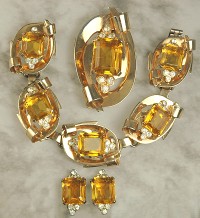 |
|
Jeray Sterling Parure |
|
Reverse Carved Lucite:
Lucite that has been carved on the back and painted. |
|
Rhinestone: Synthetic
stones or imitation diamonds made from glass, acrylic or
high quality crystal that is faceted. They are called
"Strass" in German. |
|
Rhodium: An expensive
silver- colored shiny metal that belongs to the platinum
family. |
|
Rhodochrosite: A soft
mineral that is rose pink to light pink and has cream
colored banding. |
|
Rhodolite: A durable,
rose to violet gemstone. A form of garnet. |
|
Rhodonite: "Rose" in
Greek, it is a pink to red mineral that is opaque and
can have black inclusions. |
|
Ring: Jewelry that is
worn around the finger. |
|
Ring Guard: A ring
that is worn to keep a more valuable ring from slipping off
the finger. |
|
Ring Size: A
measurement of a ring so that a person will know which ring
will fit on tier finger. A mandrel is used to determine a
ring size and to gently reshape or stretch a ring. |
|
Rivet: A technique
used for joining two flat objects together when soldering is
not advisable or wanted. For instance a pin mechanism to a
backing. Holes are drilled into the flat objects and a flat
head pin is inserted and pounded to secure the objects. |
|
Rock Crystal: The
purest form of quartz. |
|
Rolled Gold: A jewelry
term for gold filled in Europe. A thin layer of gold is
laminated to a layer of usually brass. |
|
Rolo Link Chain: A
type of chain with individually linked ovals or circles. |
|
Rondelle: A jewelry
finding that is disc shaped an often studded with stones.
They are used as spacers between other beads. |
 |
|
Rhinestone Rondell Between Swarovski Glass Pearls |
|
Rope: A pearl necklace
that is over 40" long. |
|
Rope Chain: A type of
necklace chain that looks like a rope because of the
way the small links are arranged. |
|
Rose Cut: A type of
diamond cut developed in the 16th century that has a flat
base and triangular facets. Today this style is used
mostly in for smaller diamonds. |
|
Rose Gold: Or pink
gold is gold that has been alloyed with copper and silver
giving it a pinkish look. |
|
Rose Quartz: A
translucent variety of quartz that ranges in color from deep
red to pink. |
|
Rough: Crystals or
stones that have not been polished or cut. |
|
Ruby: A gemstone that
is a red form of corundum. It is highly valued and natural
rubies are rare. One of the precious stones they are hard
and it takes an expert to tell the natural from the created. |
|
Russian Gold Finish:
Jewelry with a finish that looks like antique gold tone
metal. The appearance is matte. Miriam Haskell jewelry was
often made with this finish.
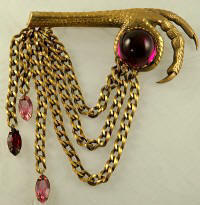 |
|
Joseff of Hollywood Russian Gold Plated Chatelaine
Shoulder Brooch |
|
|
|
Rutilated Quartz:
Quartz with inclusions called rutile crystals, that look
like hair, imbedded within them. |
|
|
|
S |
|
Safety Catch: A
second closure, for an anklet, a bracelet or necklace that is
designed to keep the piece from falling off should the primary
fastener fail. |
|
Safety Chain:
A second closure, for a
bracelet or a watch which has a chain with a clasp [usually a
spring- ring] that secures one side of the item to the other. They
are designed to keep the piece from falling off even if the primary
closure fails. |
|
Safety Clasp: A term used to
describe a number of jewelry findings that are meant to secure a
piece of jewelry to the neck, wrist of ankle. |
|
Sand Casting: A method of
producing metal castings out of sand molds. |
|
Sandstone: A rock that forms
when grains of sand get fused together. They will be coarse grainy
rocks. The minerals and type of rocks found in the area will
determine their color and behavior. |
|
Saphiret:
An opalescent stone that has a bi- colored appearance
showing colors from tan to blue. Melted gold was mixed
in with the sapphire colored glass. Created during the
19th century in Gablonz. Later stones were produced in
Germany. |
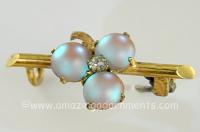 |
|
Antique Saphiret Pin |
|
Sapphire: A member of the
corundum family that comes in a variety of colors. The most common
is blue. They hard and are one of the precious stones. |
|
Sard: A variety of chalcedony
that is red to brown in color. It is a semi- precious stone and is
often carved intaglio. |
|
Sardonyx: A variety of quartz.
It is a semi- precious stone that is formed by alternating layers of
sard and onyx. It is used to make cameos. |
|
Satin Finish: A jewelry finish
that is semi- gloss. It is somewhere between a bright finish and a
matte finish. This finish is created by using a tool to scratch
parallel lines onto the metal's surface. |
|
Saturation: How the amount of
color present in a gemstone is measured. The higher the saturation
of color the more the stone will be worth. |
|
Sautoir: A long necklace in
vogue beginning in the Edwardian era usually made of chains, seed
pearls or beads and ending in a tassel. Also called a rope. It
usually extended beyond the waist |
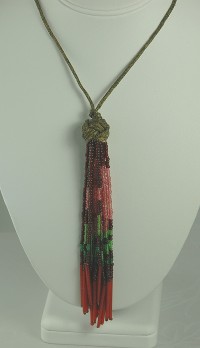 |
|
Glass Beaded Sautoir Necklace |
|
Scalloped: A decorative border
of a series of semicircular projections. |
|
Scarab: A type of beetle that
the ancient Egyptians thought was a fertility symbol. Much of the
decorations including jewelry of the day was made or carved in the
shape of this beetle. Jewelry using the scarab motif became
popular during the 1920s Art Deco period in the West following the
discovery of King Tut's tomb. |
|
Scatter Pin: A small pin that
is to be worn with one or more like sized pins. |
|
Scepter: A staff [usually
jeweled] carried by a ruler to signify power and authority. |
|
Screw- back: A type of earring
finding that tightens the earring to the ear using a flat screw. |
|
Seed Bead: A very small glass
or plastic beads usually used as spacers. They are usually 2mm or
less and can be strung alone. They can also be used to cover
findings and they can be clustered. |
|
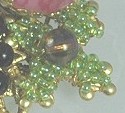 |
|
Green Glass Seed Beads Wired to Russian Gold- Plated Backing |
|
Seed Pearl: Very small natural
or imitation pearl that is usually used as a spacer with other beads
or pearls. They can also be used to top beads as Miriam Haskell did
or as the Victorians did, they can be used to weave onto other
materials. |
|
Seftonite: A variety of
chalcedony that is green. |
|
Selenite: A crystalline
variety of gypsum that is soft and near colorless. |
|
Semi- mount: A piece of
jewelry that is finished except for the center stone. This allows
the buyer to finish the piece with a stone of their choice. |
|
Semiprecious: A
characterization of gemstones that are not in the precious category.
Some of the semiprecious stones are: garnet, opal and amethyst. |
|
Serpentine Chain: A chain made
up of two layers of flat "S" shaped links that are placed very close
together. |
|
Setting: Describes how a stone
or other material is held in place. Some examples of settings are:
bezel, channel, prong and pavé. They can be closed or open. If
open, the backs of the stones will show through and more light will
be able to shine through the stone. |
|
Shank: The part of the ring
that goes around the finger. |
|
Shoulder: The part of the ring
that is between the shank and the center of the setting. |
|
Signet: A means of
identification, a signet was usually a carved design worn on a ring.
The design would serve as the identification and was used to sign or
authenticate documents. |
|
Sifter: This apparatus sits
inside a powder well of a compact. it is either mesh or gauze and is
mounted on a frame. It allows one to dispense a small amount of
powder at a time. |
|
Sifter Box: A term from the
1920s and 1930s that was used to describe a loose powder compact. |
|
Silver: A soft shiny metal
that is white in color. A precious metal and is the metal with the
highest electrical and thermal conductivity. Silver tarnishes
easily. |
|
Silver Tone: Metal that has a
silver color. |
|
Simulated Stones: A natural or
synthetic stone that is meant to imitate a gemstone. |
|
Slate: Usually formed from
shale, it is a fine grained rock that has been metamorphosed. Slate
is usually cut into slabs. |
|
Sleeper: A small hoop used to
keep the hole of a freshly pierced ear open. |
|
Smoky Quartz: A brownish
natural quartz with a smoky appearance. |
|
Snap Bar Closure: A type of
earring closure. A thin bar that lifts up and down to hold the
earring in place or to release it. |
|
Snake Chain: A metal chain
that is made up of small wavy circular links that when placed
together form a flexible tube with a finish that resembles snake
skin. |
|
Sodalite: An opaque denim blue
colored stone that exhibits some white veining due to calcite. They
often will show a fleck or two of pyrite. |
|
Soldering: Metal with a low
melting point is heated and used to join other metals together. |
|
Solitaire: A single gemstone
or diamond mounted in a simple setting. |
|
Souvenir Jewelry: Jewelry that
is made for tourists. Many jewelry companies and designers made this
type of jewelry. |
|
Sparkle: The measure of the
amount of light that passes through a diamond or stone when it is
moved and viewed at different angles. |
|
Specific Gravity: A density
measurement. The item being measured has it's weight compared with
the weight of an equal quantity of water. |
|
Spessartite Garnet: An orange
to varying shades of red, brown and yellow garnet composed of
alumina manganese. |
|
Spinel: A hard mineral that
crystallizes in the isometric system with an octahedral habit. It is
found in a variety of colors often resembling a ruby and was used a
lot for medieval jewelry. |
|
Split Ring: A jewelry finding
and used for key rings it is a ring with a opening or split that
allows for attaching charms or keys to bracelet, necklace or to a
ring. |
|
Spray Brooch: Long stemmed
floral brooches with jewels and long leaves. |
|
Spring Ring: A common jewelry
finding for joining two ends of a necklace, bracelet or anklet
together. They are hollow metal tubes in the shape of a circle. The
tube contains a small wire and a spring that holds the wire in
place. There is an arm on the tube that is attached to the wire
inside the tube. This arm allows one to open or close the clasp.
They were invented in the 1900s. |
 |
|
Spring Ring Clasp |
|
Square Cut: A method of
cutting a gemstone that is similar to the emerald cut. |
|
Squash Blossom Necklace:
Navajo necklace that uses a pomegranate motif. Beads that look like
squash blossoms are placed around a crescent shaped pendant. |
|
Stabilized Stones: Stones that
have been injected with a liquid plastic and sometimes a dye to
stabilize or fill cracks in the stone. This process improves the
stones appearance by filling in its pores. |
|
Stack Rings: Rings that are
meant to be worn one atop another on the same finger. |
|
Stamping: A method of
embossing metal. |
|
Star of Africa: The largest
diamond to be found to this point. It is also called the Cullinan
Diamond it was mined in South Africa in 1905. |
|
Star Sapphire: Natural
sapphire that exhibits a six rayed star that is colorless and
reflect the light. This asterism can make the star sapphire if
centered just so, quite valuable. They are usually cut
cabochon. |
|
Star Setting: A way of setting
a stone in an engraved star by soldering. Popular in the 1890s. |
|
Step Cut: A rectangular to
square cut with many facets parallel to the edge of the stone.
Similar to the emerald cut. The step cut is most often used for
colored stones. |
|
Sterling: To meet the industry
standard, silver must contain 925 parts per thousand silver and 75
parts copper. If this criteria is met only then is the object
considered sterling. The copper improves the silver's hardness. |
|
Stick Pin: A straight pin
often decorated on top that is worn vertically on the lapel, a hat,
a tie or a scarf. Usually they have a clutch closure that can also
be decorated. |
|
Stippled Finish: A finish that
is textured and formed by pricking the object with a steel punch. |
|
Strass: Glass that is highly
reflective and made to imitate gemstones including the cuts. |
|
Striations: Naturally
occurring lines, grooves or scratches found in a stone. |
|
Stud: A type of earring that
consists of a single stone on a straight post that goes through the
hole in a pierced ear and then is secured with a clutch. A stud will
not have a dangle or drop. |
|
Sugar Beads: Beads used to
make jewelry that have fine grains on the surface as if they had
been rolled in granulated sugar. |
|
Sunstone: A gemstone
that varies in color from orange gold to reddish brown. It is a
feldspar that is known for exhibiting a spangled appearance. |
|
Surrealist Movement:
An early 20th century [1924- 1945]European artistic movement that
emphasized the power of the unconscious. This movement spread to
America and Latin America as well. It was a revolutionary movement
whose members strove to express the unseen world and to provoke
political, social and cultural change. |
|
Swedge: A method of
constructing costume jewelry where many sections are attached with a
rivet. A prominent design technique used by DeLizza and Elster. |
|
Sweetheart Jewelry: Popular during World War Two.
Usually a pin, but bracelets and compacts and more can be found, that was given to a loved one by an armed forces
member on duty. |
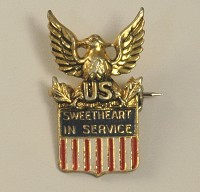 |
|
Coro Sweetheart in Service
Sterling WWII Pin |
|
Symmetry: [1] Refers to the
quality of a diamond's cut [2] Refers to how similar one side of an
object is to the other side. |
|
Synthetic Stone: Gemstones
that are made in a laboratory. It is difficult to tell these apart
from natural stones because they contain the same chemical
characteristics as they natural stones they imitate.
These are not fake stones and they usually lack imperfections. |
|
T-Z |
|
Table: The large
flat area at the top of a cut gemstone. |
|
Tanzanite: A
mineral discovered southwest of Mt. Kilimanjaro in
Tanzania Africa in 1967. It is blue violet brilliant
type of zoisite and transparent. They look a bit
like a sapphire. |
|
Tapered Baguette:
A baguette cut where on end is smaller than the other. |
|
Tarnish:
Discoloration of the surface of metal caused by a thin
layer of dirt or reactions between the metal and
chemicals. |
|
Tassel: A bundle
of thread or chain that are secured or bound one end and
left to dangle loosely on the other end. |
|
Taxco: A town in
Mexico famous for producing silver jewelry. This town in
Guerrero is where American William Spratling opened a
shop in 1929. Other silversmiths followed and soon this
town became the center for silver jewelry making. Early
[prior to 1970] Taxco jewelry is highly collectable. In
1979 the Mexican government required that silver be
stamped with a registration mark and a series of
numbers. |
|
Temper: A method
used to harden or strengthen metal by heating and
cooling it. |
|
Template: A
pattern or standard layout that is used to create a
document or to trace a design. |
|
Tennis Bracelet: A
diamond or gemstone chain bracelet that is flexible and
set with stones that are uniform in size. Tennis star
Chris Everet has been given credit for this name because
of the day at the US Open Tennis Tournament when she
dropped her diamond bracelet and had to ask for a time
out on the court to find it. |
|
Tessarae: Small
pieces of tile, glass or stone that are made into a
mosaic. |
Thermo Plastic:
Plastic that can be easily molded and shaped when
heated. Celluloid [cellulose nitrate] Acrylic or Lucite, Cellulose Acetate
and polystyrenes are examples of thermo plastics.
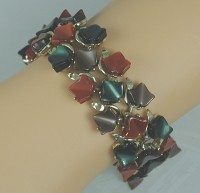 |
|
Thermoplastic Bracelet |
|
Thermoset Plastic:
Plastic that once heated cannot be melted upon reheating.
They will burn instead. Bakelite is a thermoset plastic.
Casein and epoxies are other examples.
|
|
Tiara: A headpiece
that looks like a crown, however it is semi-circular.
They are usually jeweled or embellished and worn on
special occasions. |
|
Tie Bar: Sometimes
called a "tie clasp", it is a gentleman's
accessory that secures a necktie. It usually will have a
decorated top and a clip on the back. The clip is used
to hold or grip the tie. |
|
Tie Tac: Also
written as a "tie tack". This is a pin that
secures a necktie to a shirt. The top is usually
decorated with a pin and clutch attached. |
|
Tiffany Setting: A
ring with a high six prong setting that uses slender
prongs to hold the stone. This setting was introduced by
Tiffany & Co. in 1886. |
|
Tiger's Eye: A
member of the quartz group that exhibits changeable
luster. This chatoyant quality is caused by the way the
bands of light and dark color on the surface of the
stone catch the light. They are opaque and usually brown
with lighter bands. They are seen in yellowish- brown,
reddish brown and blue. |
|
Tin: An
inexpensive malleable metal that is silvery in color and
resists corrosion. |
|
Titanium: A metal
element that is silvery- gray in color and very strong.
Called the "space age" metal is is 50% lighter than
steel. |
|
Toe Ring: Toe
rings are jewelry that is worn on one or many toes. It
is a band with a split in it to allow the ring to slip
on and off of the toe easily. Toe rings fall in
the "body jewelry" category. |
|
Toggle Clasp: A
jewelry finding that is intended to join two sides of a
bracelet, necklace or an anklet. Also called the
bar and ring clasp because there is a bar that is
inserted into a ring. The bar sits atop the ring and
keeps the jewelry item secure. |
|
Tongue Bar: Body
jewelry. A bar stud that is intended to be worn on a
pierced tongue. |
|
Topaz: A compound
of silicate, aluminum and fluorite it is hard and
transparent. They are found in many colors including
blue, white and the prized yellow-orange Imperial Topaz.
This gemstone possesses double refraction and
impressive luster. Topaz are often heat treated to
improve their color. |
|
Torque: A ridged
necklace that is often open in the front. The ends
of the openings are usually decorated. Also spelled "Torc"
these necklaces were worn by the Gauls, the Celts
and the Britons. They were often wrapped or twisted and
of metal. |
|
Torsade: A
necklace with many strands that are twisted together
before applying the end cap. |
|
Tortoise Shell:
The protective shell of certain turtles that is medium
brown and can have specks or lines that was popular for
jewelry and hair ornament making in the 1800s. It can be
heated and molded. This
material burns easily and it is now banned. Tortoise
shell is often imitated using plastic. |
|
Tourmaline: A
crystalline mineral that is found in many colors
although usually black. They have the greatest color
range of any of the gemstones. Derived from the
Singhalese word "turamalli" which means carnelian.
When found in red or green varieties that are
transparent, they are considered valuable. Watermelon
Tourmaline is both green and pink. |
|
Trademark: A mark
[name, design, phrase or symbol] that is on file with
the United States Patent Office and identifies a
retailer or wholesaler. Identified by the ® mark. This
mark legally restricts anyone but the owner from using
the mark. Use of the ™ symbol next to the
trademark tells all that the owner of the trademark
rights within the mark. There is no need to register to
use the ™ symbol. |
|
Transitional Jewelry:
Jewelry styles that overlap eras, not neatly fitting
into any one in particular. |
|
Translucent: A
surface that some light passes through, but one cannot
see through it. Examples include opals some
plastics and moonstones. |
|
Transparent: A
surface that allows light to pass through and you can
see through the surface. Examples include diamonds,
rubies and some plastics. |
|
Transvaal Jade: A
large variety of grossular garnet that is gray to green
and found in South Africa. It is very reflective,
however it is not jade. |
|
Tree Agate: Agate
with green and brown patterns that look like tree
foliage. |
|
Trembler: A piece
of jewelry with a part that moves. The moving part is
set on a spring mechanism causing it to move when the
wearer moves. Coro and Trifari [among others] trembler
pieces are very collectable. |
|
Trillion Cut: A
brilliant cut triangular stone with 44 facets. |
|
Triplet: A stone
that is manufactured by layering and fusing three thin
sections of stones together. |
|
Troy Weight:
Measurement for precious metals. The units are:
pennyweight, ounces and pounds. These measurements are
not the same as US measurements. |
| 1 Pennyweight = 24 grams =
1.5552 grams |
| 1 Troy ounce = 20
pennyweight = 31.1035 grams |
| 1 Troy pound = 12 Troy
ounces = 373.24 grams |
|
|
Tsavorite: A
relatively new gemstone that was discovered in Kenya in
1960. It is a transparent green member of the garnet
group. They are similar to an emerald except that they
are rarer. They also have a higher refractive index and
they are more durable than an emerald. |
|
Tube Catch: Also
called the Trombone clasp it is a jewelry closure
finding popular in the 1890s. It can also be found on
1940s European jewelry. |
|
Turquoise: A semi
precious opaque stone that has a bright blue- green
color. It is highly prized and was/is a popular choice
for making jewelry in several cultures. It is a hydrated
phosphate of aluminum and copper. Turquoise stones that
appear flawless were probably manufactured by using
pulverized turquoise that has been reconstituted with a
plastic binding agent. Streaks in the stones are usually
gray or brown and are caused by the matrix or the stone
from which they were mined. The Persian or Iranian
turquoise has no matrix. |
|
|
|
Ultrasonic Cleaner:
A machine that cleans jewelry without scratching the
surface of the piece. A fluid is vibrated at 20,000
cycles per second. |
|
Unakite: A form of
granite that is made up of pink feldspar, quartz, and
green epidote. it is found in Africa and the USA. |
|
Urea Bakelite: A
form of thermoplastic. |
|
|
|
Vabanite: Jasper
found in California that is brown with yellow flecks. |
|
Valadium:
Stainless steel that is so fine it resembles white gold. |
|
Vanity Case: A
case that is meant to allow one to carry cosmetics and
other items. It was usually rigid. |
|
Variscite:
Hydrated aluminum phosphate that is rare and often
confused with turquoise. This rare and translucent
mineral is sometime used for jewelry. |
|
Venus' Hair Stone:
Rutilated quartz or rock crystal. |
|
Verdigris:
A green or greenish coating that develops on metal .
Sometimes it is desirable as in aged copper. When found
on most jewelry it is considerable damage. There is
verdigris paint that is used to give some items, mostly
copper and aged finish. Some call verdigris patina.
|
|
Vermeil: Silver
and to a lesser extent bronze that has been plated with
gold. |
|
Victorian: The time
in which Queen Victoria [b 1819] of England 1837-1901 reigned.
This era was considered the height of industrial
revolution. Many styles of jewelry were created during
this time. Also during this time the British
Empire expanded by war and colonization. This period is
further divided into three periods. |
|
Vitreous: Glass
like. |
|
Vintage Jewelry:
Jewelry that is 30 years removed from the current date. |
|
Volcanic Glass:
Obsidian |
|
Vulcanite:
Plastic
that is hard and black or brown in color that was
popular for jewelry during the mid and late Victorian
era. Many pieces of mourning jewelry were made from
vulcanite. This moldable early rubber is also
called "ebonite". |
|
|
|
Watermelon Tourmaline:
A gemstone that shows pink and green color.
Watermelon rhinestones also exhibit these colors. |
|
Water Sapphire: Is
an iolite and not a sapphire. They are light blue,
purplish blue or even yellowish gray. This is a soft
mineral and one stone will show many colors. |
|
Wedding Cake Beads:
A type of lamp-worked bead originally made in Murano
Italy. They are decorated with fancy overlays. |
|
White Gold: An
alloy of gold, nickel, copper, zinc, manganese, tin and
sometimes palladium. It was intended to imitate platinum
during WWII. |
|
White Metal: An
alloy of non- precious metals. Pot metal. |
|
|
|
Xenolith: An
inclusion. |
|
|
|
Y Necklace: A
style of necklace that has a dangle portion attached to
a regular chain. This design looks like the letter "Y"
when worn. |
|
Yellow Gold: Gold
alloyed with half silver and half copper. |
|
YGF: Yellow gold
filled. |
|
|
|
Zinc: A bluish
white metallic element. It is plentiful and brittle at
room temperature. Once heated zinc is malleable.
Zinc does not oxidize easily. |
|
Zircon: A gemstone
that is found in a variety of colors. Pure Zircon is
colorless and most are brown. |
|
Zoisite: An opaque
gray-green mineral found in cracks of rocks. They can
also have streaks of green and black. |
|
|
|
|
|
|
|
|
|
|